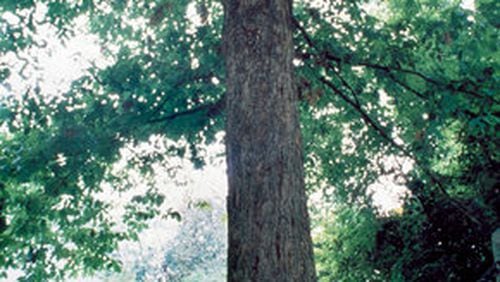There's no better way to mark Arbor Day than by visiting one of Georgia's finest trees, The Tree That Owns Itself. Tourists have come for more than 100 years to see a white oak with the unusual distinction of owning itself.
The tree lives in a shaded neighborhood at the corner of South Finley and Dearing Streets in Athens. The tree is inside a small fenced-in circle of land that juts into the middle of the street, cutting off one lane of traffic along South Finley. There are two engraved stones dedicated to the tree, one of which is more faded than the other. According to Billy Paugh, community forestry coordinator for Athens-Clarke County, The Tree That Owns Itself stands 70 feet tall and is 35 inches wide.
As the legend goes, Col. William Henry Jackson, reportedly a professor at UGA, had fond childhood memories of the tree and wanted to protect it. According to a newspaper story from 1890, Jackson wrote a will that read:
I, W. H. Jackson, of the county of Clarke... do convey unto the said oak tree entire possession of itself and of all land within eight feet of it on all sides.
Despite its vague origin, the tree's status is accepted in Athens. As one writer put it, "However defective this title may be in law, the public recognized it."
Roger Cauthen, Athens-Clarke County's landscape management administrator, told the Atlanta Journal-Constitution the city considers the tree part of the right of way on South Finley Street and takes care of it, despite the folklore of its self-ownership.
"It's quite a story, but we treat it as kind of a public street tree," Cauthen said. "If there was outside damage, like from a storm, we would prune the damage. It has little to no signs of damage or stress."
Weather has proved troublesome for Athens' most famous tree in the past. The tree that stands today is actually The Son of The Tree That Owns Itself. The original suffered from erosion and an ice storm in 1907. It fell by 1942 because of infected roots. Estimates from the time say it was 150-400 years old and more than 100 feet tall.
A new tree was planted in 1946 in the same spot using acorns from the original. It is generally known by the same name as its father and accorded the same self-ownership.
At the time, Mrs. Dudley of the Junior Ladies Garden Club told the Athens Banner-Herald, "(The Club) believes that Athens needs another Tree That Owns Itself, to perpetuate the romantic tradition, and to satisfy the many tourists, who come searching for it annually."






